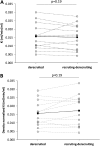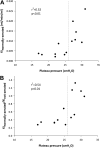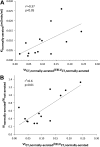Lung regional metabolic activity and gas volume changes induced by tidal ventilation in patients with acute lung injury
- PMID: 21257791
- PMCID: PMC3114052
- DOI: 10.1164/rccm.201008-1318OC
Lung regional metabolic activity and gas volume changes induced by tidal ventilation in patients with acute lung injury
Abstract
Rationale: During acute lung injury (ALI), mechanical ventilation can aggravate inflammation by promoting alveolar distension and cyclic recruitment-derecruitment. As an estimate of the intensity of inflammation, metabolic activity can be measured by positron emission tomography imaging of [(18)F]fluoro-2-deoxy-D-glucose.
Objectives: To assess the relationship between gas volume changes induced by tidal ventilation and pulmonary metabolic activity in patients with ALI.
Methods: In 13 mechanically ventilated patients with ALI and relatively high positive end-expiratory pressure, we performed a positron emission tomography scan of the chest and three computed tomography scans: at mean airway pressure, end-expiration, and end-inspiration. Metabolic activity was measured from the [(18)F]fluoro-2-deoxy-D-glucose uptake rate. The computed tomography scans were used to classify lung regions as derecruited throughout the respiratory cycle, undergoing recruitment-derecruitment, and normally aerated.
Measurements and main results: Metabolic activity of normally aerated lung was positively correlated both with plateau pressure, showing a pronounced increase above 26 to 27 cm H(2)O, and with regional Vt normalized by end-expiratory lung gas volume. This relationship did not appear to be caused by a higher underlying parenchymal metabolic activity in patients with higher plateau pressure. Regions undergoing cyclic recruitment-derecruitment did not have higher metabolic activity than those collapsed throughout the respiratory cycle.
Conclusions: In patients with ALI managed with relatively high end-expiratory pressure, metabolic activity of aerated regions was associated with both plateau pressure and regional Vt normalized by end-expiratory lung gas volume, whereas no association was found between cyclic recruitment-derecruitment and increased metabolic activity.
Figures





Comment in
-
Regional lung strain and inflammation.Am J Respir Crit Care Med. 2012 Jan 15;185(2):228-9; author reply 229-30. doi: 10.1164/ajrccm.185.2.228. Am J Respir Crit Care Med. 2012. PMID: 22246708 No abstract available.
References
-
- Bellani G, Messa C, Guerra L, Spagnolli E, Foti G, Patroniti N, Fumagalli R, Musch G, Fazio F, Pesenti A. Lungs of patients with acute respiratory distress syndrome show diffuse inflammation in normally aerated regions: A [18F]-fluoro-2-deoxy-d-glucose PET/CT study. Crit Care Med 2009;37:2216–2222. - PubMed
-
- Jones HA, Clark RJ, Rhodes CG, Schofield JB, Krausz T, Haslett C. In vivo measurement of neutrophil activity in experimental lung inflammation. Am J Respir Crit Care Med 1994;149:1635–1639. - PubMed
-
- Musch G, Venegas JG, Bellani G, Winkler T, Schroeder T, Petersen B, Harris RS, Melo MF. Regional gas exchange and cellular metabolic activity in ventilator-induced lung injury. Anesthesiology 2007;106:723–735. - PubMed
-
- Hartwig W, Carter EA, Jimenez RE, Jones R, Fischman AJ, Fernandez-Del Castillo C, Warshaw AL. Neutrophil metabolic activity but not neutrophil sequestration reflects the development of pancreatitis-associated lung injury. Crit Care Med 2002;30:2075–2082. - PubMed
-
- Chen DL, Schuster DP. Positron emission tomography with [18F]fluorodeoxyglucose to evaluate neutrophil kinetics during acute lung injury. Am J Physiol Lung Cell Mol Physiol 2004;286:L834–L840. - PubMed
Publication types
MeSH terms
Substances
Grants and funding
LinkOut - more resources
Full Text Sources
Other Literature Sources
Medical
Research Materials

